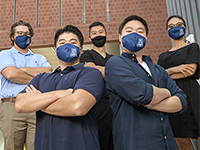Genetic and Viral Interactions in Development of Sinusitis Focus of University of Arizona Health Sciences Surgeon-Scientist
TUCSON, Ariz. Sinusitis, or sinus infections, are one of the most common illnesses in children and adults. Identifying the progression of the common cold to chronic rhinosinusitis (CRS), defined as sinusitis lasting longer than 12 weeks, will be critical in targeting therapies that slow the development of a disease affecting nearly 12% of U.S. adults with treatment and other costs exceeding $60 billion a year.
 In August, the University of Arizona Health Sciences was awarded $2.24 million by the National Institute of Allergy and Infectious Diseases, a unit of the National Institutes of Health, for a four-year study to examine cadherin-related family member 3 (CDHR3), a protein in the respiratory tract with a genetic variation strongly associated with asthma and CRS.
In August, the University of Arizona Health Sciences was awarded $2.24 million by the National Institute of Allergy and Infectious Diseases, a unit of the National Institutes of Health, for a four-year study to examine cadherin-related family member 3 (CDHR3), a protein in the respiratory tract with a genetic variation strongly associated with asthma and CRS.
The study's principal investigator, Eugene H. Chang, MD, is vice chair and associate professor in the Department of Otolaryngology-Head and Neck Surgery at the UArizona College of Medicine Tucson. He also is an adjunct faculty member in the Departments of Medicine and Neurosurgery, and a scientist in the Airway and Asthma Disease Research Center (A2DRC) and BIO5 Institute.
The majority of sinus infections are caused by a virus, such as a cold, Dr. Chang said. Less than 2% are bacterial, so antibiotics dont help viral infections. Although most people recover after sinus infections, there are those whose symptoms last greater than 12 weeks and have chronic inflammatory changes.
Dr. Chang's laboratory focuses on how airway epithelia the layer of cells lining the respiratory tract react to chronic insults (including bacteria, viruses, fungi and allergens) through innate and adaptive immune responses. When this process is impaired, the nose and sinuses can become inflamed and infected. Dr. Chang and colleagues first identified that a mutation in the CDHR3 gene increased the odds of CRS in adults twofold in a multi-center cohort study published in the Journal of Allergy and Clinical Immunology.
A follow-up paper characterized early-life risk factors in the first longitudinal study of chronic sinusitis that analyzed a cohort, or group, of study participants from infancy to adults, using data from the Tucson Children's Respiratory Study at the A2DRC. The Tucson study is the first and longest ongoing birth cohort assessment centered on the early origins of asthma and chronic obstructive lung disease.
 Many of our patients describe the onset of their sinus disease as a cold that never goes away Dr. Chang said. Our work has identified that rhinovirus (RV) infections, responsible for the common cold, are associated with development of sinusitis. In particular, Rhinovirus-C (RV-C), a recently identified RV species, results in greater sinonasal symptoms and disease severity. CDHR3 is the receptor for RV-C, and we hope to determine if genetic variants of this gene predispose individuals to more severe RV-C infections and sinus disease
Many of our patients describe the onset of their sinus disease as a cold that never goes away Dr. Chang said. Our work has identified that rhinovirus (RV) infections, responsible for the common cold, are associated with development of sinusitis. In particular, Rhinovirus-C (RV-C), a recently identified RV species, results in greater sinonasal symptoms and disease severity. CDHR3 is the receptor for RV-C, and we hope to determine if genetic variants of this gene predispose individuals to more severe RV-C infections and sinus disease
Dr. Chang's lab will use airway culture models derived from patients with sinus disease and recruit CRS patients to identify risk factors for disease exacerbations.
Co-investigators on this study are Fernando Martinez, MD, co-principal investigator on the Tucson Children's Respiratory Study, Airway and Asthma Disease Research Center director, BIO5 member, UArizona Regents Professor, and the Swift-McNear Professor of Pediatrics and Chalfont/Moore Chair on Respiratory Medicine; and Dean Billheimer, PhD, professor of epidemiology and biostatistics in the UArizona Mel and Enid Zuckerman College of Public Health, a Center for Biomedical Informatics and Biostatistics member and director of the Statistics Consulting Laboratory (StatLab) at the BIO5 Institute.
This project would be impossible without the support of my mentors, collaborators, researchers and colleagues at the UArizona Dr. Chang said. In addition to Drs. Martinez, Billheimer and Steven Wang, MD, Otolaryngology department chair, he thanked James Gern, MD, a collaborator at the University of Wisconsin, and the Chang lab research members. Chris Le, MD, Tara Carr, MD, and Puneet Shroff, MD, have been instrumental in recruitment of patients with sinusitis.
Our patients have helped build one of the largest sinonasal data registries in the world, with more than 900 patients enrolled Dr. Chang said. Dr. Wang and my colleagues in the Department of Otolaryngology have been instrumental in developing a site to provide not only the best clinical care for our patients, but also a center where we can conduct research on novel therapies and potential cures for airway diseases impacting the people of Arizona and beyond
Research reported in this publication was supported by the National Institute of Allergy and Infectious Diseases, a unit of the National Institutes of Health, under Award No. R01AI146131.
# # #
NOTE TO WRITERS/EDITORS: Images area available here https://arizona.box.com/s/jbh82iueegqmmx7awlsdhkuewom0sfyi.
About the University of Arizona Department of Otolaryngology-Head and Neck Surgery
The global mission of the University of Arizona Department of Otolaryngology-Head and Neck Surgery is to improve the lives of people suffering from illnesses of the head and neck through exemplary clinical medicine, basic and translational research, and the training of the next generation of otolaryngologists. One of the newer departments at the UArizona College of Medicine Tucson, the department offers advanced educational training for current and aspiring otolaryngologists, conducts groundbreaking research and provides expert comprehensive otolaryngology (ear, nose and throat) care for patients throughout Arizona and the Southwest. For more information, please see: otolaryngology.medicine.arizona.edu (Follow us: Twitter | Instagram).
About the University of Arizona College of Medicine Tucson
The University of Arizona College of Medicine Tucson is shaping the future of medicine through state-of-the-art medical education programs, groundbreaking research and advancements in patient care in Arizona and beyond. Founded in 1967, the college boasts more than 50 years of innovation, ranking among the top medical schools in the nation for research and primary care. Through the university's partnership with Banner Health, one of the largest nonprofit health care systems in the country, the college is leading the way in academic medicine. For more information, visit medicine.arizona.edu (Follow us: Facebook | Twitter | Instagram | LinkedIn).
About the University of Arizona Health Sciences
The University of Arizona Health Sciences is the statewide leader in biomedical research and health professions training. UArizona Health Sciences includes the Colleges of Medicine (Tucson and Phoenix), Nursing, Pharmacy, and the Mel and Enid Zuckerman College of Public Health, with main campus locations in Tucson and the Phoenix Biomedical Campus in downtown Phoenix. From these vantage points, Health Sciences reaches across the state of Arizona, the greater Southwest and around the world to provide next-generation education, research and outreach. A major economic engine, Health Sciences employs nearly 5,000 people, has approximately 4,000 students and 900 faculty members, and garners $200 million in research grants and contracts annually. For more information: uahs.arizona.edu (Follow us: Facebook | Twitter | YouTube | LinkedIn | Instagram).

